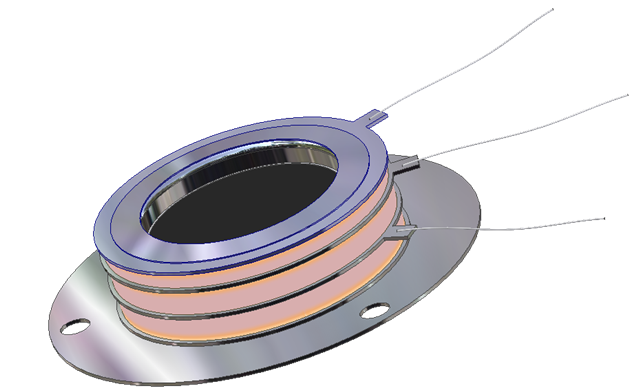
Microchannel plate response to high-intensity ion bunches.
Nuclear Instruments and Methods in Physics Research Section A: Accelerators,
Spectrometers, Detectors and Associated Equipment, Volume 557, Issue 2, Pages
516-522
S. Coeck, M. Beck, B. Delauré, V. Golovko, M. Herbane, A. Lindroth, S. Kopecky,
V. Kozlov, I. Kraev, T. Phalet
Marcus Beck is a long term Del Mar customer.
He uses MCP-MA25/2 in the research described in this article (pdf)
Microchannel Plate Detectors MCP-MA
DEL MAR Microchannel Plate Detectors MCP-MA series are an open MCP detectors
with one or more microchannel plates and a single metal anode. They are intended
for time-resolved detection and make use of high-speed response properties of
the MCPs. MCP-MA detectors are designed for photons and particles detection in
vacuum chambers or in the space.
MCP-MA detectors are used in a variety of applications including UV, VUV and EUV
spectroscopy, atomic and molecular physics, TOF mass–spectrometry of clusters
and biomolecules, surface studies and space research.
MCP-MA detectors supplied as a totally assembled unit that can be easily mounted
on any support substrate or directly on a vacuum flange. They also can be
supplied premounted on a standard ConFlat flanges.

The WITCH experiment [1] aims to investigate the Standard Model of the electroweak interaction with emphasis on finding new physics beyond the standard model. The primary goal is to search for a contribution of scalar interaction to the vector and axial-vector interaction of the standard model. For this purpose in the WITCH experiment the electron-neutrino angular correlation in beta decay will be determined. This will be achieved by measuring the recoil energy spectrum of the daughter ions after beta decay.
The WITCH experiment is located at the ISOLDE isotope separator facility at CERN [2], which can deliver a wide range of different radioactive isotopes. The isotopes are delivered in an ion beam of 60kV kinetic energy. For the WITCH experiment this ion beam is captured by the REXTRAP setup first. Here the ions are cooled and bunched. Then the ions travel to the WITCH setup in a horizontal beamline. After being bent into a vertical beamline the ions are decelerated to ~2keV kinetic energy. Then the ions get trapped in a first Penning trap. Here they get cooled and are transferred into a second Penning trap where they are stored. During the storage the ions will decay. The decay products are a neutrino, a positron and a daughter ion. The daughter ion will recoil from the trap. The recoil ions, which fly into the subsequent spectrometer, will encounter a retardation potential. Those ions with recoil energies larger than the retardation potential will be reaccelerated behind the retardation barrier and will be focused onto a microchannel plate where they will be counted individually. By varying the retardation potential the recoil energy spectrum will be measured.
Del Mar MCP-MA25/2 MCPs are used at several places for diagnostic purposes. In the vertical beamline the MCPs are used in conjunction with various collimators for beam tuning, both in the 60keV and the 2keV region of the beam. These MCPs will measure a large amount of ions in a short time (typically 10e5 ions in a couple of microseconds). In order not to destroy the detectors their operating voltage is reduced from the typical voltage of -2kV to approx. -1.3kV. Due to the high count rate per pulse the MCPs will not give individual counts but a current pulse. They are electrically read out and their signal is displayed with a digital storage oscilloscope. For a rough beam tuning this is interpreted by eye. For fine-tuning the signal is read out via the GPIB interface of the oscilloscope and is integrated in a PC. Another Del Mar MCP is used behind the traps. This MCP detector is mounted there temporarily for trapping tests and trap tuning. It detects the stable ions which are first stored and then ejected from the trap. It is operated at a normal voltage of -2kV. In normal operation, when this test detector is absent, another Del Mar MCP will be mounted on a movable arm inside the spectrometer. This detector is intended to scan the wide beam of recoil ions when it passes the plane where the detector is mounted. This will give valuable information on the trajectories of the ions inside the spectrometer. Both the trap test and the spectrometer test MCPs are read out electrically. Their pulses are formed into logical pulses and counted by a scaler.
[1] M. Beck et al., Nucl.
Instr. and Meth. A 503 (2003) 567
[2] E. Kugler, Hyperfine Interactions 129 (2000) 23
Recent publications:
M. Beck et al., Nucl. Instr. and Meth. A 503 (2003) 567
M. Beck et al., Nucl. Instr. and Meth. B 204 (2003) 521
A. Lindroth et al., Nucl. Phys. A 721 (2003) 1103c
Prepared by Marcus Beck